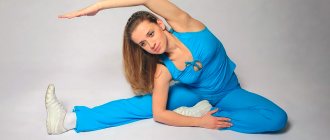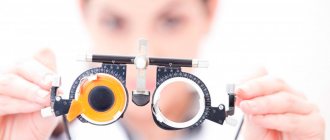The first exercises to preserve vision were created long before our era. Yogis, creating complexes for the whole body, did not forget about our eyes. They knew for sure that for the best results you need not only training, but also proper rest.
The large amount of information that we “absorb” every day requires almost constant tension from our eyes. And, naturally, they get tired. Many vision problems arise from overexertion. Even a person with a “one” needs rest for the eyes. Otherwise, after hard work, symptoms such as dry eyes, redness, and blurred distance vision may appear. What can we say about those whose vision leaves much to be desired - in this case, rest for the eyes is simply necessary. It is not without reason that W. G. Bates and his student M. D. Corbet, when creating their system for improving vision, relied heavily on this fact.
The exercises and relaxation for the eyes that will be given below (this includes both a yoga complex and exercises according to W. G. Bates and M. D. Corbet) are quite simple and will not take much time. But... everything ingenious is simple and complex at the same time. Therefore, first try to read the description of the exercise carefully. If it is written that the movement should be smooth, this is important. If recommendations are given on how to breathe, pay attention to them. Don’t forget about these “little things” and then exercise and rest will become most effective.
First - rest. Palming
Sit up straight, relax. Cover your eyes in this way: the middle of the palm of your right hand should be opposite your right eye, the same with your left hand. The palms should lie softly, there is no need to press them forcefully to the face. The fingers can cross on the forehead, they can be located side by side - as is more convenient for you. The main thing is that there are no “slits” that let light through. When you are sure of this, lower your eyelids. The result is that your eyes are closed and, in addition, covered with the palms of your hands.
Now place your elbows on the table. The main thing is that the neck and spine are almost in one straight line. Check that your body is not tense, and your arms, back, and neck should be relaxed. Breathing should be calm.
Now try to remember something that gives you pleasure: how you relaxed at the seaside, how everyone wished you a happy birthday, the starry sky... You can do this exercise to music. It is very difficult to consciously relax your eyes (remember that you cannot control your heart either). Therefore, there is no need to try to control your condition - this will only harm the purpose of the lesson; instead, think about something pleasant.
The exercise can also be done at work, giving yourself short breaks. Even in 10-15 seconds your eyes will have time to rest a little. But, of course, it will be better if you take at least a few minutes to relax.
After completing the exercise (especially if you have been doing it for quite a long time), gradually open your palms, let your closed eyes get used to the light a little, and only then open them.
"Writing with your nose"
This exercise is aimed at both relaxing your eye muscles and relaxing your neck. Tension in this area disrupts proper nutrition of the eyes (in other words, the blood supply process slows down).
The exercise can be performed lying down or standing, but is best done while sitting. Relax. Close your eyes. Imagine that the tip of your nose is a pen with which you can write (or imagine that a long pointer-pen continues the line of your nose - it all depends on what is more convenient for you, the main thing is that you and your eyes do not strain). Now write (or draw) in the air with your pen. What exactly is not important. Write different letters, names of cities and countries, a short letter to your loved one. Draw a house with smoke from a chimney (the same as you drew in childhood), just a circle or square.
If you want to relax your eyes a little while sitting straight at your desk, you can imagine that you are writing not with a pen, but with the tip of a needle on the head of a pin. Then your colleagues will not ask you what you are doing, because from the outside, the movements of your head will be almost invisible. Employees will think that you are just sitting with your eyes closed to get some rest. Which will not be far from the truth. You can relax your eyes in the same way if you are returning home from work on public transport.
"Through Your Fingers"
Relaxing your eyes can be achieved by looking without concentrating on one thing. To relieve eye tension, this exercise is suggested for you. It can be performed sitting, lying down, standing.
Bend your elbows so that your palms are slightly below eye level. Open your fingers. Make smooth turns with your head left and right, while looking through your fingers, into the distance, and not at them. Let your gaze glide without lingering on one thing. If you do everything correctly, your hands will “float” past you: it should seem to you that they are moving.
Do three turns alternately with your eyes open and three with your eyes closed (even closed eyes should not “linger” on anything. Do the exercise 20–30 times, while breathing freely, without straining.
If you can't get the movement effect, try this. Extend your index finger. He should "look" up. And your nose should touch it. Close your eyes and turn your head left and right so that your nose touches your finger as it passes by. Without stopping turning your head, open your eyes (just don’t focus your attention on your finger, look into the distance!). You will probably see the finger “moving.”
Morning complex
For those who find it difficult to open their eyes in the morning, this complex will be a real salvation. And if you can palm several times during the day (longer during your lunch break, every 1-2 hours for at least 10-15 seconds) and “write” something with your nose (during your lunch break and on your way home from work), you will feel that over time your eyes will no longer get as tired as before. You can do some exercises at night. Especially if before going to bed you watch TV, sit at the computer or read.
So let's go back to the morning.
- Stretch well, roll several times from side to side. Don't hold your breath while doing this. On the contrary, breathe deeply and calmly.
- Open your eyes and mouth wide several times.
- Close your eyes tightly (6 times), do 12 light blinks.
- Do the “writing with your nose” exercise.
- Do an eyebrow exercise (see description below).
- Make finger turns.
- Do palming.
Palming should take about 5 minutes. The rest of the complex (6 previous exercises) should take the same amount of time.
Eyebrow exercise
In the morning, many of us want to say, like Gogol’s Viy: “Lift my eyelids!” And over time they become heavier and heavier. Eyebrow exercise will not only help your eyes get rid of the pressure of this heaviness, but will also help you look younger.
Raise your eyebrows as high as possible, while observing the sensation that appears at the top of your ears. Your task is to reproduce this feeling over time without raising your eyebrows. Of course, not everyone can do this exercise right away. It is possible that when you raise your eyebrows for the first time, you will not detect any special sensations. Take your time, listen to yourself, and you will succeed.
The benefits of exercise
Eye exercises allow you to get positive results in a short time. Regular exercise not only preserves and improves visual function, but also has a beneficial effect on the condition of the entire body.
Experts note that in the process of performing eye gymnastics, a person manages to relax. This is very useful, it allows you to take your mind off things. A short rest gives you strength and allows you to prepare to solve the next work problem. It has been proven that when you do an eye warm-up, anxiety and nervousness disappear.
In addition, exercises allow you to:
- Improve memory. This is due to improved blood circulation in the brain, which stimulates brain processes.
- Improve vision. It has been proven that regular exercise can stop the development of myopia. In addition, visual acuity improves.
- Remove the effect of dry eyes. It occurs when working at a computer for a long time and is characterized by many unpleasant symptoms: burning, lacrimation, etc.
Basic yoga complex for the eyes
Yoga recommends this complex to maintain good vision. As the yogis themselves say, if you do it every morning and evening, starting from youth, you can maintain good vision until old age and not use glasses.
Before performing the complex, sit in a comfortable position (it’s good if you can sit on your heels on a gymnastic mat, but you can also sit on a chair). Straighten your spine. Try to relax all the muscles (including the facial muscles), except those that support the sitting position of the body. Look straight ahead into the distance; if there is a window, look there; if not, look at the wall. Try to focus on your eyes, but without undue tension.
Exercise No. 1
Inhaling deeply and slowly (preferably from the stomach), look between the eyebrows and hold your eyes in this position for a few seconds. Exhaling slowly, return your eyes to their original position and close for a few seconds. Over time, gradually (not earlier than after 2-3 weeks), the delay in the upper position can be increased (after six months to several minutes). Repeat the exercise 10 times.
Exercise No. 2
Inhaling deeply, look at the tip of your nose. Hold for a few seconds and, exhaling, return your eyes to their original position. Close your eyes for a short time. Repeat the exercise 10 times.
Exercise No. 3
As you inhale, slowly turn your eyes to the right (“all the way”, but without much tension). Without pausing, as you exhale, return your eyes to their original position. Turn your eyes to the left in the same way.
Do one cycle to start, then two (after two to three weeks), and eventually three cycles. After completing the exercise, close your eyes for a few seconds. Repeat the exercise 10 times.
Exercise No. 4
As you inhale, look to the upper right corner (approximately 45° from the vertical) and, without pausing, return your eyes to their original position. On your next inhalation, look to the lower left corner and return your eyes to the starting position as you exit.
Do one cycle to start, then two (after two to three weeks), and eventually three cycles. After completing the exercise, close your eyes for a few seconds.
Repeat the exercise 3 times.
Exercise No. 5
Inhaling, lower your eyes down and then slowly turn them clockwise, stopping at the highest point (at 12 o'clock). Without pausing, start exhaling and continue turning your eyes clockwise downwards (up to 6 o’clock). To begin with, one circle is enough, gradually you can increase their number to ten circles (in two to three weeks). In this case, you need to immediately start the second without delaying after the first circle. After completing the exercise, close your eyes for a few seconds. Then do this exercise by turning your eyes counterclockwise. To complete the complex you need to do palming (3-5 minutes)
Concluding the section “Gymnastics for the eyes”, we would like to note that in order to achieve the best results, you need to monitor your health in general. According to experts, good vision largely depends on proper nutrition, including the presence of sufficient vitamins. Remember that the healthiest food is natural (not artificial or canned) food, subject to minimal heat treatment. It is she who retains the greatest amount of useful substances.
Help with myopia and farsightedness
Myopia is a common vision defect. In this case, a person cannot clearly see objects in the distance. You can prevent the progression of pathology at the initial stage of pathology by regularly performing the following special exercises. Necessary:
- Blink quickly, squeezing your eyelids tightly. The movements are performed with a certain resistance up to 10 times.
- Move the eyeballs along the trajectory of eight or other figures. You should do this with the maximum range, but do not overstrain your eyes.
Farsightedness is a vision pathology when a person sees objects well in the distance, but cannot see objects close up. This problem is often accompanied by headaches and depression due to constant overexertion. In this case, it is recommended to perform eye exercises aimed at relaxation, such as:
- Pendulum. You need to hold the pencil in front of your eyes and swing it, while your eyes need to track its movements.
- Candle. The exercise is done in a darkened room. It is necessary to light a candle and observe the flame from different positions.
- Surveillance. On the street or while on the balcony, you need to follow the selected object with your eyes.
"Draw" the letters
Drawing in the air allows you to relax not only the eye muscles, but also the neck. Close your eyes and imagine that there is a felt-tip pen or art brush attached to the tip of your nose. First, try writing several letters in the air, alternating their size each time. Some letters can be stretched over the entire wall, while others can be placed on some small object. For example, on a TV or refrigerator. At the same time, it is not at all necessary to “draw” only letters with an imaginary pen. You can try to draw vertical and horizontal eights, geometric shapes and various simple illustrations.
Children's gymnastics
The methods described above are suitable for adults and adolescents. They can charge themselves. Young children should be forced to do this and monitored during gymnastics. Come up with a game to keep your child interested. The very principle of gymnastics remains the same. You need to follow the tip of the pencil, draw geometric shapes in the air, blink often and relax.
Do exercises daily, only in this case they will bring positive results.
How to improve vision without surgery
There are many methods to correct visual impairment. The most common of these include glasses and contact lenses. However, these products only help during the wearing process. Optical aids cannot cure myopia. Specialists
In this article
- How to improve vision without surgery
- Eye exercises for myopia
- Bates technique
- Reviews from doctors
- Benefits of eye exercises
Many exercise options have been developed that can both correct and significantly improve the ability to see. Let's look at how to restore vision with myopia at home without medications.
Reviews from doctors
The above gymnastics options help strengthen the eye muscles. Restoring vision through exercises is possible with long-term daily sessions. But the method developed by Bates is not recognized by official medicine; it causes controversy among specialists, since it is not effective for all types of diseases. For example, they do not take into account changes that occur with glaucoma or retinopathy. In this case, gymnastics can even do harm. Therefore, before starting classes, it is imperative to consult an ophthalmologist. The specialist will tell you how you can restore your vision with exercises in the event of a particular ophthalmological disorder.
Causes of visual impairment in children and adolescents
Until recently, the main patients of ophthalmologists were old people, but in the last couple of decades the problem has been rapidly rejuvenating. And more and more parents are bringing their children to eye doctors. What is the point of such a dramatic rejuvenation of visual problems?
| Issues | Causes |
| Children's vision loss | Transitional age Heredity Pathologies at birth Birth injuries Excessive passion for gadgets |
There are actually many more reasons! By understanding at least the basic ones, you can prevent many future problems that can develop into significant pathologies. Why vision deteriorates in children is discussed above. There is even a fact that premature babies lose their vision faster over time. It is impossible to prevent heredity. Therefore, constant inspections and monitoring should not be neglected. But there are acquired reasons. These are what you need to control in order to somehow insure your vision.
Exercises for the eyes to restore vision in case of farsightedness may be completely useless if the condition of the visual apparatus is neglected. So, the very first acquired reason is severe strain on the eyes. When children gnaw on the granite of science, the volume of study amazes parents. Constant concentration on small objects - intraocular pressure makes a sharp jump upward. This problem can lead to the development of an irregular crystal shape. More than serious vision problems arise. Working with smartphones is being added to everyday life. It is impossible to limit work with them. Because even if they are banned, the search for the necessary information takes place exclusively through the Internet. Eye exercises to improve vision will not help in that rare case when a child becomes blind due to incorrect posture. Curvature and problems with the vertebral discs in the back block normal blood circulation in the vessels, because of this, blood does not flow normally to both the brain and the eye apparatus. And in this case, the ophthalmologist is not God. You will need a doctor who works with the spine and nerve endings.
Another option for eye problems is lack of physical activity, oddly enough. Any physical activity is oxygen, which, like air, is necessary for organs and tissues; it accelerates blood formation and all metabolic processes. And that's the argument. Vision also decreases due to oxygen starvation. Sports should not be neglected, especially if the parents gave the child bad heredity.
The lack of vitamins and minerals and their sharp deficiency can completely damage vision. A child has a growing body, he needs the right vitamin set. Neither mom nor dad, no matter how much they want, can keep track of what the child eats at school or on the street. But there is a group of vitamins that are directly responsible for the condition of the entire visual apparatus:
- B-group;
- Folic acid;
- Zinc or iron-containing vitamins.
To adjust your diet, you will have to develop a diet at home. A set of exercises to improve vision will help prevent the loss of children's vision. This, in turn, can lead to the following negative consequences.
It’s worth starting to sound the alarm if everything suddenly begins to blur before your eyes, and in the distance a person stops seeing normally. This is how false myopia can manifest itself. The reason for this is excessive fatigue. Spasms also occur in the visual apparatus, which is why clarity is lost. You need to make light rotational movements, stroke your eyes with light pressure, leave them alone, a simple exercise to improve vision in case of myopia will help restore vision. But if you do not pay attention to such spasms, then false myopia can very easily become real.
In addition to myopia and farsightedness, there are also vision problems such as astigmatism. The whole point here is in the wrong form. Moreover, disturbances and transformations can occur in the lens, and the eyeball can get a damaged shape. This is where the lack of clarity and focus in the picture comes from.
Not far behind astigmatism is the problem of lazy eye syndrome. The muscles lack strength and the eyes turn off the picture. In this case, the frame of each eye is not combined into one. Due to this anomaly, the image of one eye is turned off. And he stops focusing and rolls into his eye. All this negativity can be avoided only through timely ophthalmological care.










